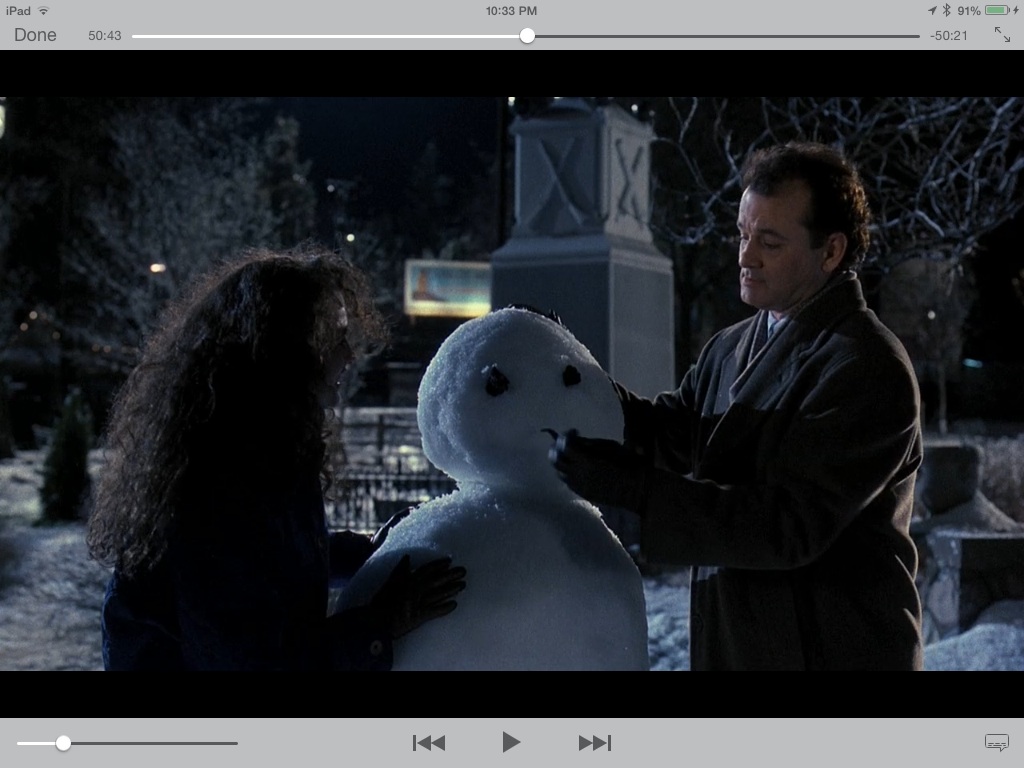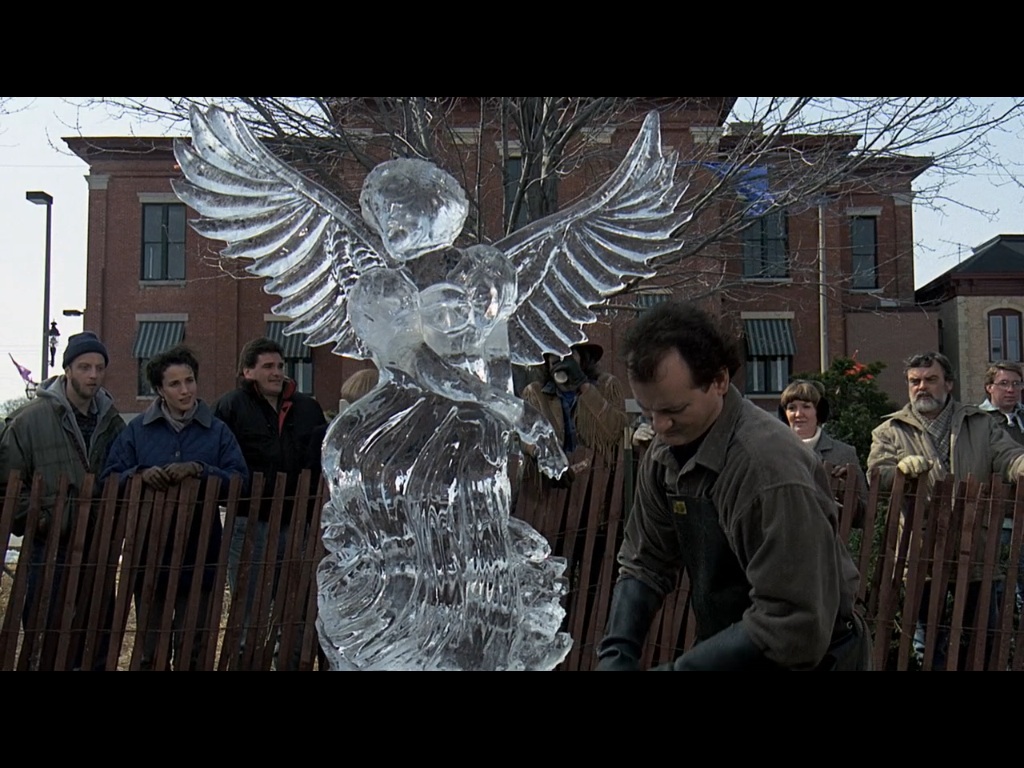put some cherry syrup on the top
Warning: I am in the mood for meaning, apparently.
Predictions show a steady low,
You’re feeling just the same.
But seasons come and seasons go.
I’ll make you smile again.
If you don’t believe take me by the hand,
Can’t you feel you’re warming up? Yeah, I’m your weatherman.They say it’s gone, say winter’s done
That don’t mean a thing.
‘Cause I’m the one that moves the sun
For you I’d turn it into spring
So when you’re feeling lonely, try to understand,
Baby, I can warm you up ‘cause I’m your weatherman.
The lyrics to Weatherman heard just before and after the bit inside the van on the ride to Punxsutawney. Benesh (2011) says it just "masquerades as a pop romantic love song" (p. 90). She thinks there's more to it. Obviously, the lyrics themselves give us a metaphor, winter for a low mood, spring for being happy. Benesh's take is interesting, since if we choose to link the song to the characters, we would presume this is Phil talking to Rita; he's the weatherman, and we all know this is a romantic comedy when we go in. I think sometimes it's the film itself (or Harold Ramis, director (and co-writer of the song with George Fenton)) talking to all of us about to watch it. Whatever we've got going on, no matter how stressful, no matter how depressing, a good comedy like this one can lift us up even if only for its run time. Benesh, though, suggests that "the cheerful weatherman" singing these lyrics is more like "Punxsutawney Phil, and his sad counterpart, whom he is confident he can change, sounds like early Phil Connors, who also ultimately learns to cheer and succor others by the end of the film" (p. 90). I like this one. I won't argue with it, as I am usually wont to do with Benesh. There's a yellow tab here labeled simply "I'm your weatherman."
When Benesh gets to the "reproductive metaphor" she tells us, "Mimicry and imitation is a form of reproduction because they create more of what is imitated." It's simplistic, but it's not wrong. She continues:
Mimicry and imitation also, not coincidentally, are symptomatic of and foreshadow attraction as when Rita and Phil Connors imitate one another imitating the groundhog. Phil Connors even looks into the rear-view mirror as he does so, teasing Rita about her attraction to the other Phil as he mocks. (p. 94)
While I like the point Benesh is making, I must point out that she is conflating two scenes here. In the van scene, Rita imitates the groundhog and Phil does mock her. But, it is the next morning at Gobbler's Knob that Rita imitates Phil imitating the groundhog, when he asks her, "You like your guys with the prominent upper teeth?" But, Benesh's point is not about the specifics--plus she only watched the film eight times--but to suggest a procreative metaphor in the snowman scenes, and I accept this concept; in fact, I take it further than she does. Allow me to explain.
Benesh identifies the snowman scenes as "Love Children" and once again, I do not know from where she gets her titles; on my DVD this scene would fall into the chapter called "Perfect Guy." She calls these two scenes "procreation-oriented, with Phil Connors' almost successful seduction of Rita sandwiched between them" (p. 94).
(She also says "the color white and spherical objects figure prominently and similarly in both, with Rita's blue jacket and dark hair providing contrast" but I've already complained about the presumption that these things have meaning in a film set in the winter.)
Benesh calls making a snowman an "agentic activity combined with a communal one, and act of co-creation and a symbolic act of procreation" (p. 94). I like that phrasing. My yellow tab here is labeled "snowman=child." It is the yellow tab on the next page that takes it further than Benesh does. But first, I must mention how much Benesh reads into the details of the snowman scenes. She says, "Phil Connors reinforces the procreative overtones by saying that he looks forward to making snowmen with his own children. Furthermore, Phil has agentically provided for the symbolic offspring by bringing a pipe and coal eyes with which to adorn it" (p. 94-5).
My next yellow tab here, is labeled like this: "Snowman + Ice Angel = Snow Rita." That's a different equation than Benesh is offering--though, as I said, I don't disagree with her take on this one. Benesh offers Phil+Rita=Snowman (child) but she should appreciate my equation because it gives us another visual progression through the film (or at least its second half). My equation would actually imply that the snowman, in either incarnation represents Phil, which makes a logical sense in that, despite that song in Frozen, snowmen have no place outside of winter, and Phil is trapped in not only an endless winter but this one, single day. Of course, since Rita's got her hands all over that snowman, maybe Phil's seduction has gone better than it seems.

If Phil is the Snowman, then Rita is the Ice Angel that Phil carves, oddly enough, on a day he is not pursuing a relationship with Rita. Ice sculpting, particularly sculpting this sculpture, then serves as a surrogate for Phil's former pursuit. After all, he did say Rita looked like an angel.

Now, with Snowman Phil and Ice Angel Rita out there in Ideaspace or the aether, inevitably, they must procreate. But, I will admit that it is strange that Phil's reproduction of Rita in snow would serve as the child of the previous two. Nonetheless, I will run with that for a moment. Snowman and Ice Angel get together and produce, essentially, a Snow Angel (since Rita looks like an angel).

An alternate explanation of the symbology involved here: the two Snowmen do represent Phil, pre- or early-loop Phil. We see the snowmen with their heads removed, which we could take to imply that Phil still hasn't gotten his head on straight, i.e. he is still the ego-centric jerk, only playing at being something better. The supplying of the pipe and coal eyes then are for himself; he is trying to complete himself (even if he doesn't quite a) realize it or b) know how). The Ice Angel could also represent Phil as a sort of foreshadowing figure of what he is becoming now that he has moved beyond his hedonistic pursuits or his pursuit of Rita. At the point we see Phil sculpting the Angel, we have not seen him try to save O'Reilly or help anyone else as he will on the last day of the loop. But, Phil is already becoming a better version of himself simply by having moved on from the repetitive patterns in his head--Hannam's (2008) Groundhog Day Effect. Finally, in reproducing Rita in snow, Phil has reproduced his idea of who Rita is within himself. as Daughton (1996) tells us, "He has gone from viewing a woman as a sex object to be possessed, used, and discarded, to seeing her as a role model, to be respected, admired, and emulated" (p. 149). We never actually get to see Rita being "kind to strangers and children" but Phil says she is, and I think we have to believe him; everything else he says on "god day" is true. Phil has become the better person he sees in Rita. So, the sculpture progression makes sense as Phil himself, a mostly unformed Snowman, with nary a substantial detail to him; then a more detailed Ice Angel, still without specific, identifying features; and finally a Snow Rita, identity-specific and realistic in detail.
Today's reason to repeat a day forever: to see a summer breeze blow away a winter storm (no matter what season it may actually be).
Comments
Post a Comment